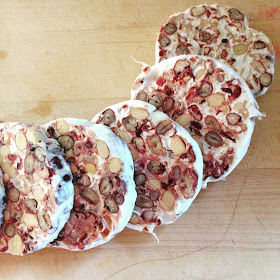 |
| Tempeh pan fried with chorizo seasoning |
If you've every looked into making tempeh yourself, believe it when you read that fresh tempeh is nothing like the stuff you buy pasteurized and packaged in the stores. Fresh tempeh smells nutty, slightly sweet, and mushroomy. When cooked, which is the only way to eat it, the nutty flavor is intensified. I'm experimenting with different additions to my mixes, so far adding different beans. I want to try a batch with added sesame seeds and peanuts (not together, though).
For my first batch, I followed the known methods carefully, incubating my tempeh in a perforated plastic bag. It turned out delicious and was a good confidence builder.
For my second batch with adzuki beans and soybeans, I pressure cooked the beans together. This was a mistake because while the soybeans stayed firm, the adzuki beans disintegrated. Still, not wanting to throw away anything, I forged ahead and mixed in the tempeh starter, Rhyzopus oligosporus. I also used glass containers with no holes during incubation. The mycelium took off! I was so glad that I didn't dump that batch over a perceived mistake.
When you don't use a plastic bag to tamp down the mold, it begins to look a little gnarly.
However, just cut the tempeh crosswise and you'll get the familiar form factor. I like how the jar made this batch of tempeh round, perfect for burgers.
My third batch took longer than 48 hour to form because I filled an entire jar to the top with the bean mixture. After 2 days, only the top half had enough mycelium, so I cut off the good part and put the rest in a shallow stainless steel try. The change of container gave more oxygen to the tempeh, and it finally took off. So, if you don't use a perforated container, only fill the tempeh mixture a 2-3 inches high so moisture evaporates instead of condensing in the container.
 |
| Delicious tempeh sandwich |
Between the tempeh I'm making and the fish the boy is catching, we really don't have a need to buy meat. It's pretty cool!
So far, I've made a Rueben marinade and a traditional, Indonesian marinade of salt water, ground coriander, and crushed garlic. Both were delicious.
Tempeh hasn't really taken off in the US, although at various times, optimistic vegetarians predicted that tempeh was going to be the next big thing. One optimist lives near me in Lafayette, CA, and he co-wrote The Book of Tempeh (an excellent read). I think one reason that DIY tempeh hasn't taken off is because people get grossed out by mold. When I posted mold pictures on Facebook and Instagram, there wasn't a favorable reaction. What I though was cool, others thought was spoiled and gross. Does this look any worse than mold-covered hanging sausages, blooming cheese, or a dead meat animal? To me it doesn't. It's the reality of food.
Lately, I've been thinking of tempah as tofu's wild, tastier, cousin. I love tofu, especially fresh tofu, but it's a bitch to make in comparison to tempeh. Plus, it's mild. Tempeh, depending on how long you ferment it, can have a blue cheese funk.
If you want to make your own tempeh, I got my starter from Cultures for Health.
My blog posts are infrequent, at best, so if you want to see what I'm up to, follow me on Instagram. My user name is sungoldtomato.




